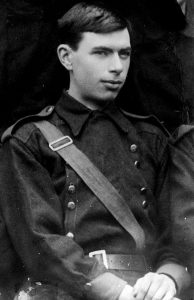Edward Daly (1891 – 1916) - Commandant of Dublin's 1st battalion

Born in Dublin on 21 February 1891, Sean Heuston was the son of clerk John Heuston and Maria McDonald.
He was educated by the Christian Brothers, and worked as a railway clerk in Limerick. While in Limerick, Sean took an active part in Fianna Éireann, of which he was an officer.
Under his guidance the Fianna in Limerick had a course which encompassed not only drilling, signaling, scout training and weapons training, but also lectures on Irish history and Irish language classes.
In 1913, Sean was transferred to Dublin Fianna, and was appointed to the Emmet Sluagh. In Dublin, he would also join the Irish Volunteers. He was Director of Training for Fianna Eireann as well as being Vice-commandant of the Dublin Battalion and Commander of the 5th company.
Heuston was the Officer Commanding the Irish Volunteers assigned to hold the Mendicity Institution on the south side of Dublin city. Acting under orders from James Connolly, Heuston was to hold this position for three or four hours, to delay the advance of British troops. This delay was necessary to give the headquarters staff time to prepare their defences.
Having successfully held the position for the specified period, he was to go on to hold it for over two days, with twenty-six Volunteers. With his position becoming untenable against considerable numbers, and the building almost completely surrounded, he sent a dispatch to Connolly informing him of their position.
The dispatch was carried by two Volunteers, P. J. Stephenson and Seán McLaughlin, who had to avoid both sniper fire and British troops across the city. It was soon after sending this dispatch that Heuston decided to surrender.
Séamus Brennan, a member of the Mendicity Institution Garrison under Heuston, gave the following account of the decision to surrender:
“Our tiny garrison twenty-six—had battled all morning against three or four hundred British troops. Machine-gun and rifle fire kept up a constant battering of our position. Seán visited each post in turn, encouraging us. But now we were faced with a new form of attack. The enemy, closing in, began to hurl grenades into the building. Our only answer was to try to catch these and throw them back before they exploded. Two of our men, Liam Staines and Dick Balfe, both close friends of Seán’s were badly wounded doing this. We had almost run out of ammunition. Dog-tired, without food, trapped, hopelessly outnumbered, we had reached the limit of our endurance. After consultation with the rest of us, Seán decided that the only hope for the wounded and, indeed, for the safety of all of us, was to surrender. Not everyone approved but the order was obeyed and we destroyed as much equipment as we could before giving ourselves up…”
According to a statement given by Séamus Brennan, the British troops were “infuriated when they saw the pygmy force that had given them such a stiff battle and caused them so many casualties”.
“They screamed at us, cursed us, manhandled us. An officer asked who was in charge and Sean stepped out in front without a word… We were forced to march to the Royal Barracks with our hands up, held behind our heads. In the Barracks we were lined up on the parade ground. Here we were attacked by British soldiers, kicked, beaten, spat upon.”
Sunday, 7th of May, Heuston was given the guilty verdict and told he would be shot at dawn.
Sean Heuston was 25 years old.